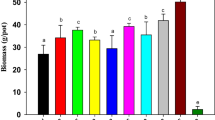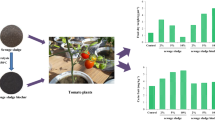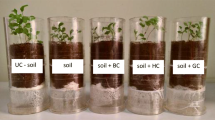Abstract
The effects of sewage sludge (SS) and its derived biochar (SSBC) on the availability and uptake of polycyclic aromatic hydrocarbons (PAHs) and potential toxic elements (PTEs) by Solanum lycopersicum (tomato) fruits grown in contaminated urban soil were investigated. Increasing application rates of SS and SSBC (2, 5, and 10 %) decreased PAH availability and, correspondingly, PAH accumulation (22–39 and 48–62 %, respectively) into tomato. SSBC was more effective in this regard. The available concentrations of PAHs (Σ16PAH) in the SSBC treatments were significantly reduced (from 30.0–47.3 %) as compared to the control treatment. The availability of high-molecular-weight PAHs (containing four to six benzene rings) was greatly affected, while low-molecular-weight PAHs (containing two to three benzene rings) was less affected by SSBC amendments. The addition of SSBC showed the least effect on bioaccumulation of naphthalene (two-ring PAH; 24.5–32.6 %), while the highest effect was observed for benzo(b)fluoranthene (five-ring PAH; 3.1–86.8 %) and benzo(g,h,i)perylene (six-ring PAH; 51.8–84.2 %). In contrast, increasing application rates of SS successively increased PTE (As, Cd, Cu, Pb, and Zn) availability and accumulation (15–139 %) into tomato while SSBC successively decreased PTE availability and accumulation (17–91 %). Changes in accumulation varied with PTE and the extent to which PTE concentrations in soil was elevated.




Similar content being viewed by others
References
Ahmad M, Lee SS, Yang JE, Ro HM, Lee YH, Ok YS (2012) Effects of soil dilution and amendments (mussel shell, cow bone, and biochar) on Pb availability and phytotoxicity in military shooting range soil. Ecotox Environ Safe 79:225–231
Ahmad M, Rajapaksha AU, Lim JE, Zhang M, Bolan N, Mohan D, Vithanage M, Lee SS, Ok YS (2014) Biochar as a sorbent for contaminant management in soil and water: a review. Chemosphere 99:19–33
Ahmed HK, Fawy HA, Abdel-Hady ES (2010) Study of sewage sludge use in agriculture and its effect on plant and soil. Agric Biol J N Am 1(5):1044–1049
Baran S, Oleszczuk P (2003) The concentration of polycyclic aromatic hydrocarbons in sewage sludge in relation to the amount and origin of purified sewage. Pol J Environ Stud 12:523–529
Beesley L, Marmiroli M, Pagano L, Pigoni V, Fellet G, Fresno T, Vamerali T, Bandiera M, Marmiroli N (2013) Biochar addition to an arsenic contaminated soil increases arsenic concentrations in the pore water but reduces uptake to tomato plants (Solanum lycopersicum L.). Sci Total Environ 454–455:598–603
Brennan A, Jiménez EM, Alburquerque JA, Knapp CW, Switzer W (2014) Effects of biochar and activated carbon amendment on maize growth and the uptake and measured availability of polycyclic aromatic hydrocarbons (PAHs) and potentially toxic elements (PTEs). Environ Pollut 193:79–87
Cai C, Zhang Y, Reid BJ, Nunes LM (2012) Carcinogenic potential of soils contaminated with polycyclic aromatic hydrocarbons (PAHs) in **amen metropolis, China. J Environ Monit 14:3111–3117
Cao X, Ma L, Liang Y, Gao B, Harris W (2011) Simultaneous immobilization of lead and atrazine in contaminated soils using dairy-manure biochar. Environ Sci Technol 45:4884–4889
CEC (2000) Council of the European Community, Working Document on Sludge, 3rd Draft, Brussels, 27 April, 2011; P. 20
Chen Z, Chen C, Liu Y, Wu Y, Yang S, Lu C (1992) Study on soil background values in Fujian province. Chin J Environ Sci 13:70–75
Chen B, Zhou D, Zhu L (2008) Transitional adsorption and partition on nonpolar and polar aromatic contaminants by biochars of pine needles with different pyrolytic temperatures. Environ Sci Technol 42:5137–5143
Creamer RE, Rimmer DL, Black HIJ (2008) Do elevated soil concentrations of metals affect the diversity and activity of soil invertebrates in the long-term? Soil Use Manag 24:37–46
Dai J, Xu M, Chen J, Yang X, Ke Z (2007) PCDD/F, PAH and heavy metals in the sewage sludge from six wastewater treatment plants in Bei**g, China. Chemosphere 66:353–361
EC (2001) Pollutants in urban wastewater and sewage sludge. Luxembourg: Office for Official Publications of the European Communities, UK
Fagbemi L, Khezami L, Capart R (2001) Pyrolysis products from different biomasses: application to the thermal cracking of tar. Appl Energy 69:293–306
Freddo A, Cai C, Reid BJ (2012) Environmental contextualization of potential toxic elements and polycyclic aromatic hydrocarbons in biochar. Environ Pollut 171:18–24
Hale SE, Lehmann J, Rutherford D, Zimmerman AR, Bachmann RT, Shitumbanuma V, ƠToole A, Sundqvist KL, Arp HPH, Cornelissen G (2012) Quantifying the total and bioavailable polycyclic aromatic hydrocarbons and dioxins in biochars. Environ Sci Technol 46:2830–2838
Han Y, Boateng AA, Qi PX, Lim IM, Chang J (2013) Heavy metal and phenol adsorptive properties of biochars from pyrolyzed switchgrass and woody biomass in correlation with surface properties. J Environ Manag 118:196–204
Hossain MK, Strezov V, Chan KY, Ziolkowski A, Nelson PF (2010) Agronomic properties of wastewater sludge biochar and bioavailability of metals in production of cherry tomato (Lycopersicon esculentum). Chemosphere 78:1167–1171
IBI (2012) The International Biochar Initiative standardized product definition and product testing guidelines for biochar that is used in soil. Final version (IBI-STD-01: revision date 15 May 2012). http://www.biochar-international.org/sites/default/files/Guidelines_for_ Biochar_That_Is_Used_in_Soil_Final.pdf. Accessed on 31.07.2012
Jeffery S, Verheijen FGA, Velde MVD, Bastos AC (2011) A quantitative review of the effects of biochar application to soils on crop productivity using meta-analysis. Agr Ecosyst Environ 144:175–187
Jiang J, Xu RK (2013) Application of crop straw derived biochars to Cu(II) contaminated Ultisol: evaluating role of alkali and organic functional groups in Cu(II) immobilization. Bioresour Technol 133:537–545
Khan S, Aijun L, Zhang S, Hu Q, Zhu YG (2008) Accumulation of polycyclic aromatic hydrocarbons and heavy metals in lettuce grown in the soils contaminated with long-term wastewater irrigation. J Hazard Mater 152:506–515
Khan S, Chao C, Waqas M, Arp HPH, Zhu YG (2013a) Sewage sludge biochar influence upon rice (Oryza sativa L) yield, metal bioaccumulation and greenhouse gas Emissions from acidic paddy soil. Environ Sci Technol 47:8624–8632
Khan S, Wang N, Reid BJ, Freddo A, Cai C (2013b) Reduced bioaccumulation of PAHs by Lactuca satuva L. grown in contaminated soil amended with sewage sludge and sewage sludge derived biochar. Environ Pollut 175:64–68
Khan S, Reid BJ, Li G, Zhu YG (2014) Application of biochar to soil reduces cancer risk via rice consumption: a case study in Miaoqian village, Longyan, China. Environ Int 68:154–161
Kookana RS, Sarmah AK, Van Zwieten L, Krull E, Singh B (2011) Biochar application to soil: agronomic and environmental benefits and unintended consequences. Adv Agron 112:103–143
Latawiec AE, Reid BJ (2009) Beyond contaminated land assessment: on costs and benefits of bio accessibility prediction. Environ Int 35:911–919
Lehmann J, Joseph S (2009) Biochar for environmental management: an introduction. In: Lehmann J, Joseph S (eds) Biochar for Environmental Management: Science and Technology. Earthscan, London, pp 1–12
Lehmann A, Rillig MC, Thies J, Masiello CA, Hockaday WC, Crowley D (2011) Biochar effects on soil biota- A review. Soil Biol Biochem 43:1812–1836
Liu X, Zhang A, Ji C, Joseph S, Bian R, Li L, Pan G, Paz-Ferreiro J (2013) Biochar’s effect on crop productivity and the dependence on experimental conditions—a meta-analysis of literature data. Plant Soil 373:583–594
Lu K, Yang X, Shen J, Robinson B, Huang H, Liu D, Bolan N, Pei J, Wang H (2014) Effect of bamboo and rice straw biochars on the bioavailability of Cd, Cu, Pb and Zn to Sedum plumbizincicola. Agric Ecosyst Environ 191:124–132
Lucchini P, Quilliam RS, DeLuca TH, Vamerali T, Jones DL (2014) Does biochar application alter heavy metal dynamics in agricultural soil? Agric Ecosyst Environ 184:149–157
Luo F, Song J, **a W, Dong M, Chen M, Soudek P (2014) Characterization of contaminants and evaluation of the suitability for land application of maize and sludge biochars. Environ Sci Pollut Res 21(4):8707–8717
Marks EAN, Alcañiz JM, Domene X (2014) Unintended effects of biochars on short-term plant growth in a calcareous soil. Plant Soil 385(1–2):87–105
Méndez A, Gómez A, Paz-Ferreiro J, Gascó G (2012) Effects of sewage sludge biochar on plant metal availability after application to a Mediterranean soil. Chemosphere 89:1354–1359
MEP (2007) Standard of soil quality assessment for exhibition sites. Ministry of Environmental Protection, the People Republic of China. (HJ 350-2007) (in Chinese). 2007; Accessed on 21.03.2013
Oleszczuk P, Zielińska A, Cornelissen G (2014) Stabilization of sewage sludge by different biochars towards reducing freely dissolved polycyclic aromatic hydrocarbons (PAHs) content. Bioresourc Technol 156:139–145
Qiao M, Cai C, Huang Y, Liu Y, Lin A, Zheng Y (2011) Characterization of soil heavy metal contamination and potential health risk in metropolitan region of northern China. Environ Monit Assess 172:353–365
Roca-Pérez L, Martínez C, Marcilla P, Boluda R (2009) Composting rice straw with sewage sludge and compost effects on the soil-plant system. Chemosphere 75:781–787
SEPA (1995) Environmental quality standard for soils. State Environmental Protection Administration, China. GB15618-1995, 1995
SEPA (2005) The limits of pollutants in food. State Environmental Protection Administration, China. GB2762-2005, 2005
Singh RP, Agrawal M (2008) Potential benefits and risks of land application of sewage sludge. Waste Manag 28:347–358
Smider B, Singh B (2014) Agronomic performance of a high ash biochar in two contrasting soils. Agric Ecosyst Environ 191:99–107
Wan Q, Yuan JH, Xu RK, Li XH (2014) Pyrolysis temperature influences ameliorating effects of biochars on acidic soil. Environ Sci Pollut Res 21(4):2486–2495
Waqas M, Khan S, Qing H, Reid BJ, Chao C (2014) The effects of sewage sludge and sewage sludge biochar on PAHs and potentially toxic element bioaccumulation in Cucumis sativa L. Chemosphere 105:53–61
Wei YL, Bao LB, Wu CC, He ZC, Zeng EY (2014) Association of soil polycyclic aromatic hydrocarbon levels and anthropogenic impacts in a rapidly urbanizing region: spatial distribution, soil-air exchange and ecological risk. Sci Total Environ 473–474:676–84
**ng B, Pignatello JJ (1996) Mechanisms of slow sorption of organic chemicals to natural particles. Environ Sci Technol 30:1–11
Xu T, Lou LP, Luo L, Cao RK, Duan DC, Chen YX (2011) Effect of bamboo biochar on pentachlorophenol leachability and bioavailability in agricultural soil. Sci Total Environ 414:727–731
Acknowledgments
This research work was financially supported by the National High-Tech R&D Program of China (863 Program 2012AA 06A 204), National Natural Science Foundation of China (41271324), CAS-TWAS, and CAS Young International Scientist programs.
Author information
Authors and Affiliations
Corresponding authors
Additional information
Responsible editor: Hongwen Sun
Electronic supplementary material
Below is the link to the electronic supplementary material.
ESM 1
(DOC 167 kb)
Rights and permissions
About this article
Cite this article
Waqas, M., Li, G., Khan, S. et al. Application of sewage sludge and sewage sludge biochar to reduce polycyclic aromatic hydrocarbons (PAH) and potentially toxic elements (PTE) accumulation in tomato. Environ Sci Pollut Res 22, 12114–12123 (2015). https://doi.org/10.1007/s11356-015-4432-8
Received:
Accepted:
Published:
Issue Date:
DOI: https://doi.org/10.1007/s11356-015-4432-8




